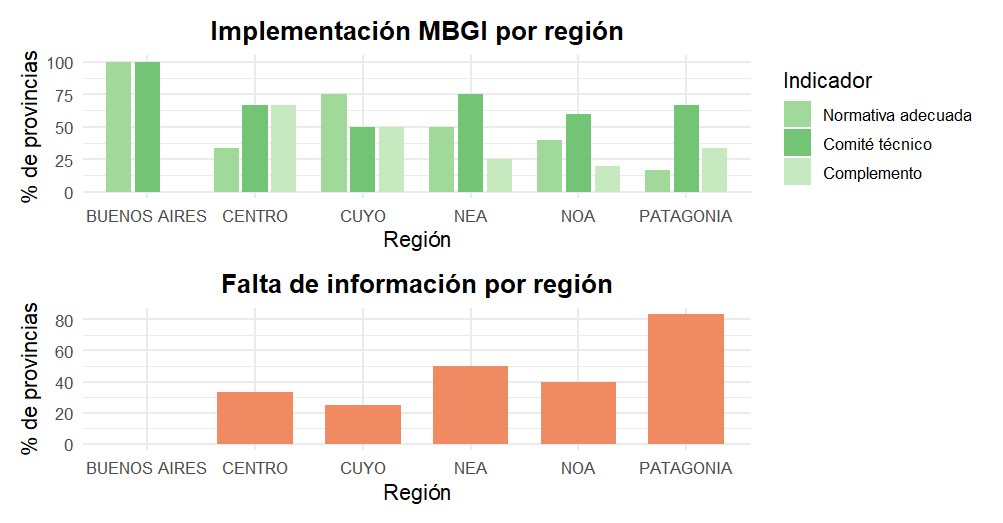14.2
Published on
At the national level, implementation of the Integrated Forest Management with Livestock (MBGI) Plan shows partial, uneven progress across regions. Only 43.5% of provinces have aligned their regulations with the MBGI approach, whether through updates to their Native Forest Land-Use Planning (OTBN), new resolutions incorporating MBGI as a plot-level management plan, or agreements with the national government to implement the national plan at the provincial level. Meanwhile, 60.9% of provinces have established technical committees (or local advisory councils, as the national plan specifies) for implementation, and just 34.8% have incorporated support materials such as trainings, guides, or handbooks. The situation is further complicated by the fact that 47.8% of provinces lack information on their degree of progress, limiting monitoring and evaluation.
At the regional level, the provinces of Cuyo show the highest degree of regulatory alignment (75%), followed by the Northeast (NEA) at 50% and the Northwest (NOA) at 40%, while Patagonia records the lowest level (16.7%) and has the highest share of provinces without public or up-to-date information (83.3%). This panorama highlights the need to strengthen interjurisdictional oversight, harmonize criteria, and ensure transparency in order to advance toward a more equitable and effective implementation of MBGI nationwide.
In absolute terms, only 10 of Argentina’s 23 provinces have aligned their regulations with the MBGI approach: Salta, Jujuy, La Rioja, San Luis, Mendoza, Misiones, Chaco, Entre Ríos, Buenos Aires, and La Pampa. As for institutional coordination, 14 provinces have formed technical committees: among them, Tucumán, Santiago del Estero, Formosa, Chubut, Río Negro, and Santa Cruz stand out despite not yet having formally adapted regulations. Only 8 provinces complement their processes with support tools such as trainings, guides, or handbooks—for example, Córdoba, La Rioja, San Luis, Santa Cruz, and Entre Ríos—reflecting targeted efforts in capacity-building and outreach. However, in 11 provinces (Tucumán, Córdoba, Santiago del Estero, Catamarca, San Juan, Corrientes, Formosa, Neuquén, Chubut, Santa Cruz, and Tierra del Fuego), accessible or updated information on MBGI implementation could not be identified, which represents nearly half the country and reveals significant gaps in management and tracking. The situation is particularly critical in Patagonia, where only La Pampa has advanced with specific regulations, while the other five provinces show regulatory delays and information shortcomings.
Fig. 1. Bar chart of percentages and distribution of MBGI regulatory alignment by region
Table 1. Regulatory alignment by Province and Region
Table 1. Regulatory alignment by Province and Region
According to the First Progress Report on the Implementation of the Second National Plan for Adaptation and Mitigation to Climate Change (November 2024): “Twenty provincial agreements were signed in support of Joint Resolution No. 02/2022 between the then Ministry of Environment and Sustainable Development and the then Ministry of Agriculture, Livestock and Fisheries, by the provincial jurisdictions. Efforts are underway to secure the three remaining agreements (Formosa, Salta, and Mendoza). Eight Provincial MBGI Technical Committees became operational during 2023 (in the provinces of Tucumán, Santa Fe, San Luis, Buenos Aires, Corrientes, Mendoza, Misiones, and Río Negro). Twenty-seven MBGI project ideas were identified and endorsed by the Local Advisory Councils (CCL) in the provinces of Santa Fe (4), Tucumán (2), Salta (4), Chubut (6), and Chaco (11). The 27 MBGI ideas cover an area of 22,338 hectares. Six MBGI project ideas were approved by the Provincial MBGI Technical Committee (CTP) in two provinces (four in Buenos Aires, two in Jujuy), pending submission to and endorsement by the corresponding Local Advisory Council (CCL). In the remaining provinces, work is advancing on the pre-identification of ideas in accordance with the eligibility criteria and guidelines established at the national level and within each jurisdiction for MBGI.”


